P.C. Zick's Blog, page 33
June 13, 2014
Book Review Friday – A Fitting Place
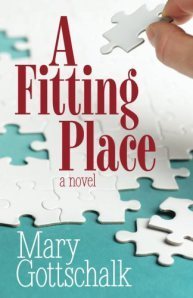 Mary Gottschalk’s first novel A Fitting Place wraps the reader in a familiar blanket in the opening pages. A lovely surprise awaited me as I began reading a story told a hundred different ways of a marriage breaking up when a husband falls for someone younger. Lindsey Chandler and her story of growth leaves the typical and takes the reader on her journey to find out just what her “fitting place” is in the world.
Mary Gottschalk’s first novel A Fitting Place wraps the reader in a familiar blanket in the opening pages. A lovely surprise awaited me as I began reading a story told a hundred different ways of a marriage breaking up when a husband falls for someone younger. Lindsey Chandler and her story of growth leaves the typical and takes the reader on her journey to find out just what her “fitting place” is in the world.
Lindsey’s world crumbles and her teenage daughter Zoey crumbles right along with her. Gottschalk doesn’t shy away from the issues as Zoey crashes into a full-blown case of bulimia, and Lindsey realizes the perfect world of her marriage and family never really existed except in the pages of a fantasy created after her own troubled childhood. As a result, Lindsey explores different avenues on her journey, including an affair with another woman.
I loved the juxtaposition of Lindsey’s two female friends in the book. Dee is the friend we all have, born from their husbands’ friendship. But the friendship with Dee is based on certain presumptions, one of which is that Lindsey and Ted are happily married. When it becomes evident that isn’t true, neither Dee nor Lindsey know exactly what to do, but they keep trying. Lindsey realizes she’s never been honest with Dee about her feelings, while at the same time realizing she’s never been truthful to herself. Joan represents the “friend” whose friendship is based on something other than mutual respect. Soon enough Lindsey realizes that Joan needs Lindsey to be a certain way, just as Ted did during their marriage. Lindsey explores a sexual relationship with Joan and enjoys the results; however, she also realizes that she prefers the intimacy of men.
While it may seem this book is an examination of sexual preferences, I didn’t feel that was the main theme. It’s just an interesting side plot.
This book is about love–all kinds of love. There is the love we have for a partner; there is the love we have for our children; there is the love we have for our dearest friends; and there is the love we develop over time with people who are thrust into our lives without having chosen them. That type of love is portrayed by Gottschalk in the guise of Lindsey’s mother-in-law. Through this relationship, the reader sees how we can often misinterpret others and make judgements without taking the time to talk to another person.
A Fitting Place works on many levels. I found myself pushing for certain outcomes of the book (no spoilers here), but then sat back and enjoyed the writing of Gottschalk. She’s just as meticulous in her prose in this book as she was in her memoir Sailing Down the Moonbeam.
I recommend A Fitting Place if you love to enter vicariously into the world of a character as she searches for a better self, which includes love in all its choices and incarnations.
Disclosure: I received an Advanced Review Copy A Fitting Place in exchange for an honest review.


June 11, 2014
Author Wednesday – Mary Gottschalk
 Welcome to Author Wednesday once again. Today I welcome back fellow author Mary Gottschalk who appeared on Writing Whims more than a year ago. I reviewed her first book Sailing down the Moonbeam, a memoir from her time of living on a sailboat while her marriage crumbled around her.
Welcome to Author Wednesday once again. Today I welcome back fellow author Mary Gottschalk who appeared on Writing Whims more than a year ago. I reviewed her first book Sailing down the Moonbeam, a memoir from her time of living on a sailboat while her marriage crumbled around her. 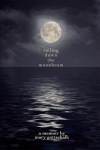 Now Mary has turned her hand to writing fiction with the publication of A
Now Mary has turned her hand to writing fiction with the publication of A 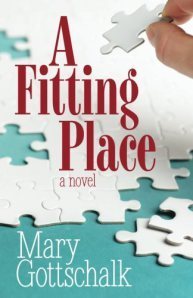 Fitting Place. I’m thrilled she’s returned to talk about switching gears from nonfiction to fiction.
Fitting Place. I’m thrilled she’s returned to talk about switching gears from nonfiction to fiction.
Welcome, Mary. Tell us a little bit about how your two books are connected. Do they have a common theme or thread?
Yes — the concept that you grow the most when you are outside your comfort zone, when your core beliefs and values are challenged, when your habitual ways of getting though the day don’t work.
It’s tempting to think of one’s “comfort zone” as a place in which you can get through life with minimal stress. In fact, many sociologists and psychologists use the term to describe a set of behaviors that got you through the traumas of childhood, but are not necessarily healthy or effective in adult relationships.
And even if you do function effectively in your personal and professional, it’s hard to grow and develop as a human being if you stay in an environment where everything is safe and familiar.
The French author, André Gide, captured this notion beautifully: “One does not discover new lands without consenting to lose sight of the shore for a very long time.”
Excellent quote, and I so agree. You do a beautiful job of expressing that philosophy in your books, Mary.
What is it that’s inspired you to include this thread in both books?
It’s a concept that has played a key role in my own life.
I’ve been something of a risk-taker since childhood, out of both curiosity and an intolerance for routine and repetition. Even so, I spent much of my early life ensconced in the comfort zone defined by my parents, teachers, bosses, and friends. Although I went to the right schools, got the right jobs, and married the right sort of man, I lived in constant fear of being found wanting.
And then I made the decision to walk away from all those expectations. At the time, the decision to quit my job and sail around the world with my husband seemed outrageously risky. In retrospect, it was one of the smartest decisions I ever made. By leaving my comfort zone for a world in which everything was foreign, I could recreate myself, based on what I wanted, not what I thought others expected of me.
I intended for Sailing Down the Moonbeam to be “my story,” but as the memoir progressed, I realized that “the story” belonged on a larger stage. Sailing on the ocean is a metaphor for the whole of life: you can’t control your environment, the path is not well marked, and you often end up someplace other than where you set out to go.
Moonbeam is a story of a woman who makes a conscious decision to step out of her comfort zone. But most people can’t quit their jobs and head off into the sunset. I itched to write a story that could happen to any woman.
Voilà, I wrote the novel A Fitting Place in which my protagonist remains surrounded by friends, family and her career, but begins to grow in new ways when she is forced out of her comfort zone by changing circumstances.
How did you choose the title, A Fitting Place? Has it been the title from the very beginning?
No, it came during a regular session with my writing buddy Carol Bodensteiner. As we talked about how Lindsey was “trying on” a different way of life, we thought immediately of a fitting room.
However, the title works as a metaphor on multiple levels:
A Fitting Room – A fitting room is not just a place to check sizes, but also be a place to try on a new persona — a dramatically different style or color. How would I look in purple? Would I feel sexy or tart-y in a dress with a plunging back? Over the years, dressing rooms yielded some unexpected treasures, but also a host of purchases that languished in a closet until I carted them off to Goodwill.
Lindsey’s love affair offers an opportunity to try a different way of living and loving. But will a same-sex relationship stand the test of time, or will it founder just as her previous relationships with men have foundered?
The Biblical Notion of Fitting — The term “fitting” appears in the Bible, usually referring to actions that are appropriate rather than “right” in an a priori or moralistic way.
For most of her life, Lindsey tried to do the “right” thing, often subordinating her needs to what she assumed was expected of her. Only when Lindsey begins to take responsibility for her own actions—to do what fits her situation rather than what she thinks is expected—do her chronic stomachaches ease.
A Jigsaw Puzzle – For many years, Lindsey felt that some critical piece of information or insight was missing from her life. But the missing pieces were largely of her own making, a consequence of her tendency to withhold information about herself. The puzzle pieces began to fall into place when Lindsey began to share more about her own needs, and negotiate day to day life based on a realistic assessment of the stakes.
I love that the title has so many layers. It all “fits.” How long do you estimate it took you to take the book from an idea to a finished, published?
I found a draft of chapter one dated January 2008, more than six years ago. I’ve never felt weighted down by the time it’s taken—a fact that seems surprising for someone who dislikes repetition. But the story and the characters have evolved quite significantly over that period, so always felt new.
Also, there were a couple times when I set it aside for three–six months. It’s so easy for an author to fall in love with her own words … and putting it aside means you can come back with a less jaundiced eye.
I agree that time away from a work can bring new perspective. I started my current work in progress in 2006, and let it alone for seven years. But I never forgot the characters. I’m always curious about when other writers discover they have a voice. When did you first discover your voice as a writer?
It was rather late in life. As a voracious reader, I always recognized a distinctive “voice” when I saw it, but I’d never tried to define it. I had no idea how to find my own voice when I turned my hand to creative writing at age sixty.
Although I’ve been a prolific writer since childhood, almost everything I wrote had a purpose—a term paper, my senior thesis in college, a report to a client, an opinion piece for the New York Times or Wall Street Journal. With this kind of writing, where my goal was to present a set of ideas and concepts logically and persuasively, I made a conscious effort to silence anything that might be considered a personal point of view or an individual voice.
I did, from time to time, keep a journal (mostly when I was traveling) and for a brief period in college, I tried my hand at poetry. But until I started on my memoir, Sailing Down the Moonbeam, it never dawned on me that I needed a voice — or that I didn’t have a voice.
Writing a memoir strikes me as a wonderful way to find your voice, since you know what happened, and how people—most importantly, you as the author—felt about the events. I don’t mean to make light of the challenge of writing realistic and three-dimensional characters, but if you tell your story well, your voice will emerge.
I’ve never thought of it that way. It’s very logical. What is the best thing a reviewer could say about one of your books?
Gottschalk’s characters explore “edgy” or “provocative” issues in a way that gives the reader “a shiver of recognition” at the universal human dimension of even an unfamiliar situation or experience.
I love “shiver of recognition.” Such a powerful thing to have said about your writing and to realize as a reader. Are your books traditionally or self-published? Why did you choose one over the other?
I decided to self publish for two reasons. First of all, I had good luck with self-publishing my memoir from a process point of view. Getting a book produced is a bit like putting on a gala: you have to make a list of all the tasks and then check them off, one by one. It’s tedious, but not hard. And since high-quality Print on Demand (e.g., Create Space) is now available, A Fitting Place was even easier to do, with considerably less upfront cash.
But the second reason is that it is almost impossible for the average author to make any money. Advances are small, and you need to sell a lot of books before you begin to receive royalties. Then too, the royalties on e-books are ridiculously small when you consider that they are zero cost to the publisher. These days, I make significantly more money from the e-book edition of Moonbeam than I do from the paperbacks.
Yes, that’s the reality of book publishing today, and thank goodness we have that choice. I’m so happy you stopped by today, Mary. It’s always a treat to hear from my fellow authors.
Be sure to stop by Writing Whims on Friday for my review of A Fitting Place.
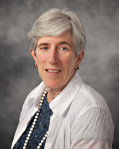 About Mary: Mary has made a career out of changing careers. Her mantra comes from Ray Bradbury: “Jump off the cliff and grow your wings on the way down!”
About Mary: Mary has made a career out of changing careers. Her mantra comes from Ray Bradbury: “Jump off the cliff and grow your wings on the way down!”
Mary spent nearly thirty years in the financial markets, working with major corporations in New York, New Zealand, Australia, Europe, and Mexico. Along the way, she dropped out several times, the first time to embark on the three-year sailing voyage that is the subject of her memoir, SAILING DOWN THE MOONBEAM.
In her latest incarnation, she is a writer and lecturer, with emphasis on the personal and professional benefits that come when you step outside your comfort zone.
Click on titles for links to Mary’s Work:


June 4, 2014
Author Wednesday – Cate Beauman
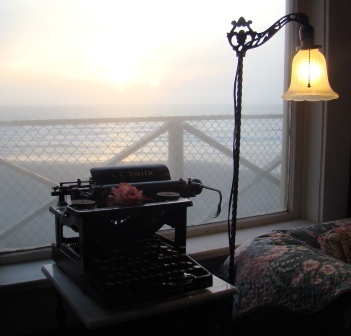 Welcome to Author Wednesday. Today Cate Beauman stops by Writing Whims to tell us about her new release Justice for Abby. Cate is the widely successful author of the romantic suspense series, The Bodyguards of L.A. County. Justice for Abby is the sixth book in this series.
Welcome to Author Wednesday. Today Cate Beauman stops by Writing Whims to tell us about her new release Justice for Abby. Cate is the widely successful author of the romantic suspense series, The Bodyguards of L.A. County. Justice for Abby is the sixth book in this series.
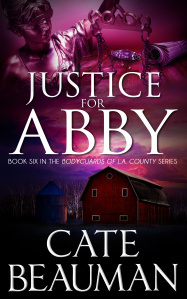
Click on cover for Amazon page
Welcome back, Cate. You’ve been busy since you last visited. Since you’re relatively new (and successful) as an author, tell us when you first discovered your voice as a writer?
I’ve always said that my writing career started from divine intervention. I never had a burning desire to write. I didn’t even know I could. I remember the day I decided I was going to tell stories. It was October 2010 and nothing seemed to be going right in my life. My family and I had just made a cross-country move that didn’t go particularly well. I’d accepted a job position similar to the one I had always loved in New Hampshire only to hate it in the school system I was working for. I ended up resigning, gorging myself on chocolate, and reading Nora Robert’s novels to soothe my soul. One evening after finishing yet another book, I had this epiphany that I was going to tell a story about a bodyguard and the woman he would protect. Five Amazon bestsellers later, and I never looked back.
That’s quite amazing. So you took a down time in your life to turn it around to something quite amazing. Good for you. So tell us what writing rituals have you developed?
I’m a mom and wife before I’m anything else, but storytelling takes a close second! I follow the same routine pretty much everyday. Each morning starts by getting the kids ready and off to school. I typically tidy up the house because I can’t stand working in a mess. Next, I sit down to check e-mail, play a quick game of Bejeweled or Mahjong Tiles to clear my mind and get to work. I work until the kids come home, cook dinner, help with homework, and get back to it after everyone heads to bed.
Nice. I like to play hearts on my computer to clear my head, so I’m happy to hear someone else does that same thing. You’ve been writing this series since the beginning, but I’m curious if all six of these books have the same thread.
They sure do! All of my books thus far chronicle the close protection agents from Ethan Cooke Security.
We all get bad reviews at some point, but it’s never easy.What advice can you give to other writers about receiving a bad review?
Not everyone is going to like our work. I never read my reviews, good or bad, because they aren’t written for me. They’re written to share their opinions with other readers.
That is an excellent philosophy and practice. I find the reviews mean less to me the more I get. How did you choose the title, Justice for Abby?
Justice for Abby sort of came to me, as have all of the titles for my books. I felt this title fits this story well because Abby’s finally getting her chance to face the men who tried to ruin her life.
Tell us a little bit about how you came up with the plot for Justice for Abby.
The idea for Justice For Abby came to me one evening while watching an episode of Vanished with Beth Holloway. The story of a young woman named Amy Bradley vanishing from a cruise ship caught my attention. They believe she is still alive and stuck in the horrific world of human sex trafficking. I couldn’t stop thinking about her horrible situation and started my research into the subject immediately after.
I always tell folks who wonder where I get my ideas to just read the paper or watch television. Ideas are rampant. Human sex trafficking is certainly an intriguing and horrific topic. Since you’ve recently switched careers, how does your immediate family feel about your writing life?
I’m very lucky to have a wonderful husband and kids. They are very supportive of my career. It’s not uncommon to discuss plot snafus or character issues over dinner along with how everyone’s day was. I couldn’t do what I do without their understanding. There are days when dinner is late or I’m lost in my own head during first and second draft mode, and my men just roll with it!
How wonderful. I couldn’t do what I do without the support of my husband and my grown daughter either. My daughter is one of my beta readers, and I find her opinions invaluable. It sounds as if you keep a busy schedule with the family and your writing, so what do you do during your down time?
I don’t have a whole lot of down time. My world revolves around two active kids, two huge dogs, and storytelling. When I do take a break, I like to make jewelry or spend time with my family.
It sounds as if you’ve found your niche and with your family’s support, I know you’ll be writing many more books. Thank you so much for stopping by today, Cate. I wish you much more success with your books.
 About Cate Beauman: Cate currently lives in Tennessee with her husband, their two boys, and St. Bernards, Bear and Jack. She is the author of the best selling romantic suspense series, The Bodyguards of L.A. County. Before her career as an author, Cate worked in special education for 12 years.
About Cate Beauman: Cate currently lives in Tennessee with her husband, their two boys, and St. Bernards, Bear and Jack. She is the author of the best selling romantic suspense series, The Bodyguards of L.A. County. Before her career as an author, Cate worked in special education for 12 years.
“I’m a pretty lucky girl; one day I woke up and my entire life changed. I saw the light, so to speak, and decided I was going to be a writer. Now, three years later, I’m working on my seventh novel, Saving Sophie, and I’m an Amazon best selling author. I’m very grateful for the support and success I have had.” – Cate
Contact Cate:
Social links:


May 30, 2014
Book Review Friday – The Bone Church
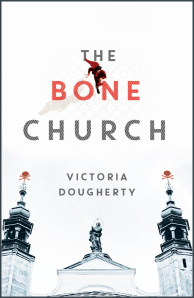
Click on cover for Amazon page
The Bone Church by Victoria Dougherty with its suspenseful moments and supernatural whispers places it in a unique category of historical fiction.
Set in Czechoslovakia between the years of 1943 to 1956, the characters are in constant danger, and one-step away from death throughout the entire book. Even when World War II ends, and Nazi Germany no longer controls the destiny of the Czech people, another world power brings a different set of troubles to the Eastern European country. It’s not certain if the occupation by the Soviet Union is an improvement upon the lives of the already downtrodden. If they managed to escape the war, it was only to end up in another type of nightmare where anyone—lovers, relatives, nuns—might end up as a spy and an enemy.
In the world portrayed by Ms. Dougherty, the characters of Felix and Magdalena are at first innocents caught in an evil and dangerous world. But with each betrayal and with every death, they lose their innocence as they scratch their way to survival.
The plight of Jews and gypsies provide the reader no surprises here; but the addition of priests, sculptors, and bankers into the complicated plot woven by the author, lend an air of constant tension to the book.
The plot moves back and forth from 1943-44 to 1956 to give just enough of a hint of what is to come and how they got where they are. Ms. Dougherty is careful to provide the chapter headings with dates and locations so the reader can easily move from one setting to the other. There’s no time to figure out the year or setting because the action never lets up in either time.
When the violence and trickery become overwhelming, the plot shifts to the paranormal where the spirits of those gone before come again to help give hope and advice to Felix and Magdalena. The reference of the Bone Church comes from a real church where human bones decorate the inside of the church. Ms. Dougherty describes in horrifying detail the interior from Felix’s point of view when he first sees it: “Nearly every part of the interior gleamed like the new teeth of an infant. Bones from some 30,000 dead Christians lay configured into pyramids, light fixtures, chandeliers, pinnacles, coats of arms, an altar, and a monstrous hydra of ribs and skulls that sat atop an intact spinal column.”
The terrifying place for Felix soon turns into his savior. The book comes full circle when the bones of one of the characters find its way to the Bone Church finally to find peace.
Ms. Dougherty’s imagery stands out from the heaviness of the plot’s action. I was captivated from the beginning with a description of Palestine, where Magdalena had visited as a child.
“The desert there had seemed to her a beautiful sleeping woman. If the mountains were her body, the desert was the palm of her hand, cracked with the lines of her destiny. The hot air was her breath.”
If you’re a fan of historical fiction, this book provides yet another experience of a dark time in Eastern European history. If you love suspenseful thrillers with spies lurking around every corner, then The Bone Church will surely keep you turning the page. And if you love a tale with paranormal assistance, you find it here. I hit the jackpot because I love all three of those elements within fiction.
Click here to purchase The Bone Church on Amazon.


May 29, 2014
#Maya Angelou – Aspire to her Greatness
 Originally posted on Living Lightly:
Originally posted on Living Lightly:

Maya Angelou at the first inauguration of President Bill Clinton in 1993
We lost a great one yesterday with the passing of Maya Angelou. But thank goodness she passed through this life and graced us with her presence.
I loved turning my students onto the poetry of Ms. Angelou. When she was called upon to write and recite a poem for Bill Clinton’s first inauguration in 1993, she had less than three months to write a poem on command for a world debut. As a writer, I can’t imagine the pressure that must have been, but Ms. Angelou did it. All she ever wanted was to be a blessing in this lifetime. She far exceed her own expectations.
The poem she created for the nation, On the Pulse of Morning, is chilling in its preciseness of language, thrilling in its dramatic contrasts, and loving in its portrayal of hope…
View original 170 more words


May 28, 2014
Author Wednesday – Victoria Dougherty
 Welcome to Author Wednesday. Today I welcome Victoria Dougherty, who has just published her first novel, The Bone Church. Set in Prague over the past fifty years, this historical thriller encompasses political, cultural, and historical boundaries.
Welcome to Author Wednesday. Today I welcome Victoria Dougherty, who has just published her first novel, The Bone Church. Set in Prague over the past fifty years, this historical thriller encompasses political, cultural, and historical boundaries.
Welcome, Victoria. It’s my pleasure to have you drop by for an interview today. I’m always fascinated about the author’s journey, so tell us, when were you first able to call yourself a “writer” or “author?”
I don’t think there’s ever been a time when I didn’t consider myself a writer. But I didn’t see myself an author – honestly – until one of my essays got published in the New York Times. Not because I needed the NYT’s blessing to call myself an author, but because the sheer volume of mail I got from readers was staggering. I don’t think I had an imagination for how that would change my perception of what it means to be an author. It was a bit of a bucket of cold water, too, because as good as it made me feel, I also felt tremendously vulnerable. The only other times I’d felt that vulnerable was when I fell in love with my husband, and when my first child was born.
Wow – I’m very impressed. An article in The New York Times? That was my penultimate goal when I was a journalist. So now that I now I’m rubbing elbows with the elite, tell me your writing rituals?
Not interesting. I just sit down and type.
That’s it, isn’t it? It’s as simple, and as complicated, as all that. I’m a great fan of Rachel Carson, the author of Silent Spring. She once said in an interview that she never chose a subject because as a writer, the subject chose her. Has this ever happened to you?
I can’t think of a time when the subject didn’t choose me. Even when I’ve written speeches for others, somehow it always seemed like the subject was chosen for me. Go figure. In terms of my fiction, I grew up in what my husband describes as “the ultimate Cold War family” – with a little bit of the Austro-Hungarian Empire and World War II thrown in for good measure. So, writing noirish Cold War spy thrillers with a ghostly twist sort of came naturally to me. That, and the fact that I live in a very old, haunted house may have helped. Maybe I just channel spirits or something and they tell me what to write.
I find that aspect of The Bone Church very compelling. What messages or themes do you try to convey to your readers?
My stories are about spies, killers, and dangerous pursuits, but they’re also about love. Of getting caught in history’s massive tailwind and blown to the other side of the world, yet despite everything, discovering the meaning of faith and love.
That’s the best message of all. Who has most influenced your writing and why?
The three authors who have made the greatest impression on me are Raymond Chandler, John Steinbeck, and Harper Lee. But Dracula by Bram Stoker is probably my favorite novel of all time – even though I’m neither into Gothic stories or vampires as a rule. It’s just so highly original and has given us a character that we’ll take through the ages.
Those are very noble choices. I would say John Steinbeck is one of the greatest influences on my writing as well. What are your current projects?
Right now I’m writing my second Cold War historical thriller. It’s called The Hungarian and it’s an adventure, a spy-thriller, and a love story all rolled into one. The Hungarian examines the intersection of three lives – a drifting ex-pat, a fugitive Russian diplomat, and a Hungarian assassin with a weakness for rich food and sadistic murder.
That’s sounds as intriguing as The Bone Church. What knowledge have you acquired recently that might assist other writers?
You are not an island and you cannot succeed without learning to market your work.
It sounds as if all your books have a common theme or thread. Would you say this is true?
I’m interested in how people behave under intense pressure and how historical forces make sweeping changes in people’s lives. I also have a deep personal interest in faith and love – the two driving forces in my life, and I think, in most people’s lives in one way or another. I define faith very broadly, by the way, and include atheists and environmentalists in my definition. I, personally, have met few atheists who didn’t passionately believe in their atheism and didn’t – at the very least in a roundabout way – try to convert you to their way of thinking, and I mean that with great respect. I simply think it’s part of human nature.
How does setting play a role in your books?
My books are terribly atmospheric. I love writing about places I’ve lived in or visited and fantasizing about places I’ve always wanted to see. When you have wanderlust the way I do, how can it not make its way into your work?
We’ve all gotten them at some point, so I’m wondering what advice can you give to other writers about receiving a bad review?
Bad reviews sting no matter how tough your skin. However, I think they offer gems of insight. If enough bad reviews say the same thing more or less, you have an opportunity to improve your work and that’s what we all love about being writers, isn’t it? That constant trickle of improvement. Someone recently told me that writing was like golf in that way. I wouldn’t know.
Let’s talk a bit more about The Bone Church. What’s your one sentence pitch for the book?
In the surreal and paranoid underworld of wartime Prague, lives The Bone Church.
It’s an intriguing title. How did you choose it? Has it been the title from the very beginning?
Yes, I always knew I wanted to write about the Bone Church – which really exists – I just needed to build a story around it.
How long do you estimate it took you to take the book from an idea to a finished, published?
Seven years.
What is the best thing someone could say about this book?
That it meant something to them.
What type of research did you do in the writing of The Bone Church?
I come from a family of spies, priests, and adventurers, so it was in my blood. I also lived in Prague for several years, so I got to know the part of the world I’m writing about very, very well.
Without giving us a spoiler, tell us a little bit about your favorite scene in this book.
My favorite scene is actually very short and simple. It involves Magdalena, the love interest in my story, and describes a memory she has when the scent of her late mother wafts in through a courtyard window. It’s a sad scene, but a hopeful one.
It’s a beautiful scene. Where do you write?
In my home office or on my living room couch (where I am right now). I can never seem to write in a coffee house. Too many clinking glasses. And I look lousy in a beret.
I love my couch, too. But I do go to coffee houses–never considered wearing a beret! How does your immediate family feel about your writing life?
My kids are fascinated that I write books. Both my husband and I work from home in fact. It’s kind of funny, because we find ourselves having to explain to our children that most people actually don’t work the way we do – they have to go to an office outside the home, or a hospital, or a big building with security guards. That’s a head-scratcher for them.
What do you do during your down time?
Spend time with my family. I try to savor every minute my kids still like me and want to hang around me. The clock is ticking on that one.
If a movie was made about your success as a writer, who would play you?
Anyone but a Kardashian. Are they even actors?
I’m not sure what they do, but I’m pretty sure not a one of them could portray you in a movie. You’re talented and interesting, and I’m delighted you stopped by for a few minutes today. Please come back when your new novel is released, Victoria.
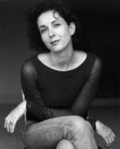 About Victoria: Victoria Dougherty writes fiction, drama, and essays that often revolve around spies, killers, curses and destinies. Her work has been published or profiled in The New York Times, USA Today, International Herald Tribune and elsewhere. Earlier in her career, while living in Prague, she co-founded Black Box Theater, translating, producing and acting in several Czech plays. She lives with her husband and children in Charlottesville, Virginia.
About Victoria: Victoria Dougherty writes fiction, drama, and essays that often revolve around spies, killers, curses and destinies. Her work has been published or profiled in The New York Times, USA Today, International Herald Tribune and elsewhere. Earlier in her career, while living in Prague, she co-founded Black Box Theater, translating, producing and acting in several Czech plays. She lives with her husband and children in Charlottesville, Virginia.
Links to books and social media sites
Victoria Dougherty’s blog, Cold
Facebook Pate: Victoria Dougherty, Author
Twitter: @vicdougherty
Click here for Amazon purchase link


May 23, 2014
Book Review Friday – The Light Never Lies
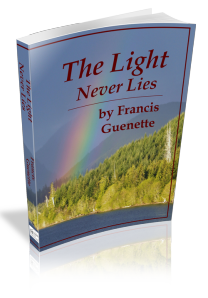
Click on cover for Amazon page
The Light Never Lies is the second in the Crater Lake Series by Francis Guenette, and last fall I read the first in the series, Disappearing in Plain Sight (click here for the review).
What a pleasure to come back to the stars of that first novel and watch as they interact with each other and the new characters that come to Crater Lake and the secluded landscape of Northern Vancouver Island, Canada .
There’s so much to love about Guenette’s writing and storytelling ability, including landscape descriptions, characterizations, and diverse conflicts.
The characters are all my friends now even if I don’t really like some of them all of the time. They are flawed; they are immature; they are secretive; they are unkind; they are human. Somewhere along the way, Guenette manages to take their flawed personalities and turn those around into positive assets. The conflicts are inner ones within both of the novels in this series. If the characters can overcome the past traumas and neglect, they will be able to soar higher than ever before. But the tension of the novel throbs with questions about whether they can survive or not.
Within the characters, I find bits of myself and others in my life. That’s what makes The Light Never Lies so compelling. Even if I don’t like some of the behaviors, I still want to be a part of the book club and the baseball team. I want an invitation to Izzy’s house for a dinner prepared by Alex and Christina, both new characters who add another element to the whole concept of family as put together by Izzy and Liam.
Izzy is my favorite character, and even though on the surface she seems perfect—beautiful, smart, accepting—Guenette gives her insecurities as she deals with her father Edward who’s come to her to spend his final days. I want nothing more than to sit with Izzy in her garden and sip on a glass of wine as the moon rises above the lake.
In this new novel, Guenette adds another dimension through the child, Robbie, wise beyond his years, and in the baby Sophie who gives them all a touchstone. Robbie’s life hasn’t been easy thus far, but his internal understanding of the world and its tangled connections shows the reader how a soul at peace can be accepting of just about anything.
I’m in awe of this talented storyteller and the rich characters she has created. The Light Never Lies is definitely character-driven novel where seriously flawed people find themselves facing ordinary circumstances where they must cope or fail.
From the metaphysical abilities of Robbie to see light around and within people to the exploration of tribal rights and insights, Guenette has woven a rich tapestry using threads created from a variety of colors and textures. Learning to let go and love others unconditionally and without reservation stand as strong messages in this novel.
Even though she manages to find resolution for the major plot lines, Guenette leaves room for the next book in the Crater Lake Series.
If you enjoy character-driven dramas that allow characters to explore their flaws with the hope of redemption always a step away, then you’ll enjoy this second book in the series. While each of the novels can stand alone, I recommend reading both of them in the order written. Why deprive yourself of missing one single second of sheer immersion in life on Crater Lake?
Disclosure: I received an Advanced Review Copy of The Light Never Lies in exchange for an honest review.


May 21, 2014
Author Wednesday – Francis Guenette
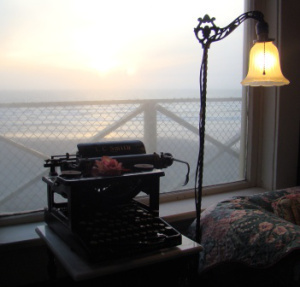 It’s Author Wednesday time once again. I’m so excited when I can welcome back a favorite author because she’s published a new book. Today I welcome back Francis Guenette who visited for an interview in November, and whose book Disappearing in Plain Sight, I reviewed back then as well. It is with great pleasure to bring Francis back for another interview, this time to discuss her new novel The Light Never Lies, a sequel to her first novel, both of which are contemporary fiction that deal with family issues and romance.
It’s Author Wednesday time once again. I’m so excited when I can welcome back a favorite author because she’s published a new book. Today I welcome back Francis Guenette who visited for an interview in November, and whose book Disappearing in Plain Sight, I reviewed back then as well. It is with great pleasure to bring Francis back for another interview, this time to discuss her new novel The Light Never Lies, a sequel to her first novel, both of which are contemporary fiction that deal with family issues and romance. 
Before we begin the interview, Francis is offering some prizes to celebrate the release of The Light Never Lies. Two softcover copies of The Light Never Lies will be mailed to the lucky winners. One for the blog host who achieves the greatest engagement with the post and one commenter – a name of a commenter drawn from a hat which includes all commenters on the blog tour. So please comment freely to win your copy. And look for my review of The Light Never Lies on Book Review Friday.
Welcome, Francis. It’s so wonderful to have you back for Author Wednesday. Let’s tell readers a bit about your new book. What’s the one sentence pitch for The Light Never Lies?
If Disappearing in Plain Sight, the first book in the Crater Lake Series, was about how a group of people get over a devastating loss and move on with their lives, The Light Never Lies is about the messiness that is the inevitable consequence of moving on.
Yes, we must deal with those messes! How did you choose the title? Was it the title from the very beginning?
There were a few common themes that emerged early in the writing process – a young boy’s special ability, the play of the light on water, and how light relates to photography.
How long do you estimate it took you to take the book from an idea to a finished, published product?
The book took one year. Here’s how that year broke down: two months doing research, notes and outlining; three months on the first draft; a month to let that draft rest; a month to do rewrites; two months working with my editor; two months of proofreading and final changes; and an intense month of formatting and preparing for publication.
You did well to keep to such a tight schedule. What is the message conveyed in this book?
Starting over is always possible, people do change, relationships can be rewritten and redefined and the concept of family is one we create as we go.
Those are some of my favorite messages as well. Explain how this book was conceived in your imagination.
Since The Light Never Lies is a sequel, most of the characters were already there, fully-developed and waiting for me to write the next chapters of their lives. I saw so much more conflict and ultimately growth for them. I started to examine the hard-fought ground they had gained for themselves in the first book so I could rip it out from under them. Being a writer is sometimes a cruel endeavor!
That’s the truth, but what fun it is to allow our characters to grow. What type of research did you do in the writing of this book?
With The Light Never Lies, I wanted to bring the reader right into the sawmill-woodlot operation and the organic bakery. I had to delve deeper, with research into each of those settings. I also did research for a particular character who had been a Native activist throughout most of his life. The places I wanted him to have been and the things I wanted him to have done needed to line up with his age and his appearances in other characters’ lives. This character needed to be able to speak convincingly about those places and situations.
I can tell readers that your research shines through in this book. Who or what is the antagonist in your book? Did you enjoy creating this character?
Both my books are written from the perspective of several characters. Depending on the reader, the protagonist and thus the antagonist shifts. In the interest of brevity, let’s assume Lisa-Marie, the feisty yet troubled and, at times, troublesome teenager, is the main character. She is the character who appears on the first page of both books, so there is a good case for her being the protagonist. In the first book, that meant Izzy, the poised and self-assured trauma counselor was the antagonist as she stood in the way of Lisa-Marie getting the guy of her dreams. In The Light Never Lies, the antagonist role shifts from Izzy to her new partner, Liam. He was once Lisa-Marie’s friend, but now he stands in the way of her primary desire to get back to what she considers normal. He is constantly calling her to a responsibility she doesn’t want to assume. I must admit, I do enjoy creating the drama and heartache that goes on in these characters’ lives. All for a good cause, mind you. It’s so nice to pull the characters back into the light – a bit older and wiser.
Interesting – I’ll have to think about that as I finish the book. Without giving us a spoiler, tell us a little bit about your favorite scene in this book.
My favorite scene is when two of the secondary characters, Maddy and Jesse, say goodbye. They have both been residents of nearby Micah Camp, a facility for troubled foster kids trying to get on with their lives, and they’ve had an intense relationship. A parting of the ways was inevitable. Even the thought of that scene makes me feel weepy.
What else do you want readers to know about your new book?

The view that inspires the writing
If you haven’t read Disappearing in Plain Sight – no problems. The Light Never Lies is a stand-alone book, but expect to be hit with a large number of characters at the start. Rest assured though, everyone is necessary and all story lines tie together and find resolution by the end. Both books will make you laugh out-loud and sniffle now and then. You’ll come away from the reading wishing you could know these people and visit the fictional setting of Crater Lake. But since you can’t do that, you might consider a vacation to the northern end of Vancouver Island for a little taste of what you’ve experienced.
I’d love to visit. The setting is beautiful in both of these books, but I really want Izzy’s house. I’m so happy you stopped by again, Francis. It’s always a pleasure.
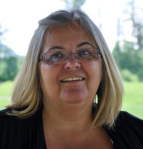 About Francis: Francis Guenette has spent most of her life on the west coast of British Columbia. She lives with her husband and finds inspiration for writing in the beauty and drama of their lakeshore cabin and garden. She has a graduate degree in Counselling Psychology from the University of Victoria, British Columbia, Canada. She has worked as an educator, trauma counsellor, and researcher. The Light Never Lies is her second novel. Francis blogs over at http://disappearinginplainsight.com and maintains a Facebook author page. Please stop by and say hello.
About Francis: Francis Guenette has spent most of her life on the west coast of British Columbia. She lives with her husband and finds inspiration for writing in the beauty and drama of their lakeshore cabin and garden. She has a graduate degree in Counselling Psychology from the University of Victoria, British Columbia, Canada. She has worked as an educator, trauma counsellor, and researcher. The Light Never Lies is her second novel. Francis blogs over at http://disappearinginplainsight.com and maintains a Facebook author page. Please stop by and say hello.
Click here for Amazon page for The Light Never Lies (U.S.)
Blog Disappearing in Plain Sight


May 17, 2014
#RomanceinAMonth – Behind the Altar
 I’m taking the plunge this month. Starting on May 15, I began writing a romance with the trope–the well-known types of romance–of Forbidden Lover with an online group headed up by good friend and colleague, Rachelle Ayala. Every day for the next month we’re to write something, and by June 14, supposedly we’ll have the first draft of a true romance.
I’m taking the plunge this month. Starting on May 15, I began writing a romance with the trope–the well-known types of romance–of Forbidden Lover with an online group headed up by good friend and colleague, Rachelle Ayala. Every day for the next month we’re to write something, and by June 14, supposedly we’ll have the first draft of a true romance.
Rachelle supplies us with the elements of a romance such as plotting suggestions, conflict and tension, and climatic scenes. It’s our choice whether we write erotica, steam, or sanitized “G” copy. Mine will probably be somewhere in the middle.
The title of my book is Behind the Altar, and I already had the cover designed by the folks at Author Marketing Club. I’m a premium member over there so I’m entitled to one free cover per year.
Leah and Dean are the forbidden lovers and right from the first chapters, life conspires to keep them apart. Here’s a few lines from yesterday’s session:
“You’re Dean?” Leah said when she found her voice. “You’re supposed to be dead.”
“I’m no Mark Twain, but it appears the reports of my death were greatly exaggerated,” Dean said.
Leah stood and came toward Jacob who reached for her hand. Leah didn’t want to be that close to him right now, not until she received an explanation of why Jacob and Geraldine had lied to her for the past three years that she’d lived with them.
“Why did you tell me he died, Jacob?” Leah asked. When her fiancé didn’t answer, she turned around to look at Geraldine. “Geraldine?”
“To us, he was dead,” Geraldine said.
“Why?” Leah asked. “Would someone please tell me what’s going on here.”
“What’s it to you, Miss Savior of the World?” Dean asked. “This is a family matter; it doesn’t concern the woman who’s been kicked out of the church hall for doing such a despicable thing as feeding the homeless.”
“You haven’t changed one bit,” Jacob said. “You’re still as nasty and spiteful as you were from the time you could throw your first mud ball. You can talk to me anyway you want, but please show my future wife respect. She’s done nothing to you.”
“Your future wife?” Dean stood looking at Leah but the sparkle in the eyes from a few moments ago seemed very far removed as these eyes flashed anger at Leah. “You’re going to marry this creep?”
Leah hesitated before nodding her head. “That was the plan, but nothing’s going to happen if I don’t get an explanation about what’s going on here.”
“I’ll leave you to your little fairy tale, princess,” Dean said. “Just know that all is not what it seems here in Baptist land. Beware of the serpents.”
Dean turned and walked out the same door he’d entered a few minutes earlier when he’d captivated Leah so thoroughly. No wonder he looked familiar, Leah thought, as she pulled away from Jacob. She ran to the door ignoring Jacob’s plea to stay there.
Time to go and write my pages for the day. I’ll keep you posted on my efforts. It’s good timing because I just finished the first draft of Native Lands, and now it’s in the hands of two Beta readers. Behind the Altar will help me pass the time while I wait for the trusted comments on a book that took far longer than a month to write.


May 16, 2014
Book Review Friday – Where It Began
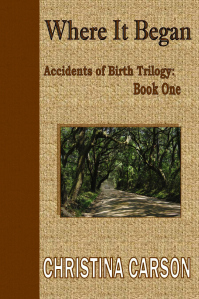
Click on cover for Amazon page
Where It Began – Accidents of Birth Trilogy – Book One
I’m a fan of Christina Carson; perhaps that’s the reason I’ve read all her books, featured her on Author Wednesday several times (06/05/2013, 03/05/2014, 05/14/2014), and reviewed her previous two books, Dying to Know and Suffer the Little Children. Today I’m excited to give a review of her latest work, which is the first book in her Accidents of Birth Trilogy. Where It Began begins where all good stories begin—of course, at the beginning.
My first comment may sound as if it’s a criticism, but it’s not. It’s probably the best thing someone could say to me about one of my books. Where It Began ended far too soon for me. I was just settling down on the front porch with a cup of coffee so I could rock away as Imogene drank her tea and told her stories. But before I could take the first sip, Imogene was saying good-bye and telling me to wait for the next book in the trilogy.
Imogene Ware, a woman of substance in spirit, tells the story of the family where she works, and so Ms. Carson writes the narrative in the dialect of the African American south in the 1960s. This takes some adjustment, but once Imogene became my best friend, I found myself thinking in the same dialect. It takes a talented author to pull off dialect, but Ms. Carson is a master.
However, it is the powerful messages Imogene imparts to the reader that most resonated with me. Her faith and spirit are powerful, yet she attributes all that she is to her own mother. No matter its source, this spirit saves the lives of more than one person in Where It Began. I’m sure that will continue in the rest of the trilogy. [Note to Christina Carson: If you are reading this review, please go back to your computer and continue writing the rest of the books in this series.]
Ms. Carson’s description of the Deep South creates a vivid portrait where the reader is captivated through all the senses. In this scene, she’s describing the hotness of August with imaginative imagery: “You smell it by what burning up around you. You taste it as dry dust gritting up on you teeth. You see it, its light so blinding white you think you in the presence of an angel. An you feel it, scorching all it touch.”
As the metaphors seeped through my skin, the philosophy of life filtered through the pages of this book for me to savor in the late hours as I waited for sleep to come. Imogene’s mama told her, “My work is to love the world.” Simple, yet powerful language Imogene pulled out to assuage her aching body and heart during the worst of times working for folks with despicable ways for loving children hurt in the wake of those ways.
This book filled me with hope and with a reminder to approach life with love in my heart, which will lead me to the proper places for healing the hurts and hatreds of the world. Ms. Carson uses Imogene’s character to show us that it’s one thing to talk about loving and doing the right thing, but that the true integrity of a person shines through when we live the talk of love. Some folks are harder to love, and there are times where it’s easier to feel bitterness in our hearts, but in the end, we all make the choice on how we live our lives, and whether or not we allow ourselves to be enslaved by the chains we’ve created.
If you’re looking for a good story with a moral heart, you’ll enjoy this read. As the story envelops you in its warm embrace, the subtle lessons will climb up into your lap as you sip your coffee or tea. You won’t even mind the scorching heat of a Mississippi summer.
Disclosure: I was given an Advanced Review Copy of Where It Began in exchange for an honest review.





